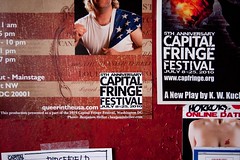Imagine a group of friends (and some hangers-on) sitting around one night talking about the club scene they used to frequent. No matter the particular scene, if you were a crazy clubkid you’ve had the post-scene breakdown, the nostalgia and the arguments about what it really meant. AWoL Productions’ The Rave Scenes is exactly like one of those nights, except the friends have an audience they are trying to educate about the scene long gone.
All the usual suspects are represented (the dealer, the dancer, the wannabe) and are helpfully nametagged as if it’s a support group meeting. In a way it is. Each personality (they aren’t really characters) is dealing with the loss of the scene and what it meant to them. Each one tries to convince the audience their version is the authentic version, and most want you to discount the drug element, which became the media and political bugbear that eventually brought the original scene down.
Be prepared for a lot of talking in The Rave Scenes. It’s a continuous conversation with no plot, and for the most part, no risk. As an audience member you will either be intrigued or bored during the roughly 75 minutes run. There’s no middle ground. At times the conversation turns almost academic, as when a laptop is pulled out and you’re read to directly from internet pages about the different EDM (electronic dance music) styles, or the genesis and result of the RAVE Act (Reducing Americans’ Vulnerability to Ecstasy, remember that priceless winner?).
There’s a momentary physical perk-up when one dance style is demonstrated (the Nordic Track, remember that?) but sadly it’s only one. I would’ve loved to have seen more dancing. Most of the energy is supplied by Ouida Maedel’s infectiously cheerful PLUR girl’s attempts to inspire us to celebrate the positive elements of rave (Peace! Love! Unity! Respect!), while any conflict comes through in the heated discussion (with a spot-on Danny Pushkin as the dealer) about the importance or non-importance of drugs.
Though there are a few nods to the DC rave scene – mentions of megaclub Nation and the famous Buzz dance party, including the controversy that led to Buzz’s initial 1999 demise, also Ultraworld and the Starscape parties in Baltimore – it doesn’t feel rooted so much in DC but more about exploring rave culture in general. If you have absolutely no knowledge about PLUR or EDM or Ecstasy, you could come away with a better understanding. That is, if you can hear over the Baldacchino Gypsy Bar Tent noise in the background (at one point an audience member got up and had a loud conversation with the bartender to the side. total club vibe immersion!), so if you actually were old enough to have been on the scene in the 90’s you may want to sit up close, those eardrums being so busted and all.
By the time someone asks, “Why are we talking about a scene based on dancing?” you may want to smack your forehead. Indeed. Why so much talking? The Rave Scenes would’ve benefitted from thinking a bit more outside the box about how to break out of the educational mode. Vision Director JR Russ’s program notes acknowledged that it was a risk to structure it this way, so it was a risk thoughtfully taken, and you have to admire that for Fringe. But in the end, more show and less tell would’ve been a relief.


